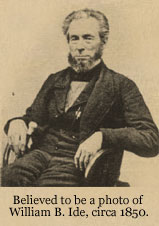William B. Ide
His father, Lemuel Ide, was a member of the Vermont State Legislature. William, a carpenter by trade, married in 1820 and he and his wife Susan settled in Massachusetts, but began moving westward, first to Kentucky, then Ohio after their conversion to the Church of Jesus Christ, and then Illinois. In Springfield, they worked their farm, and Ide taught school. In 1845, after the death of Joseph Smith, they sold the farm and joined a wagon train in Independence, Missouri headed for Oregon. On the advice of mountain man Caleb Greenwood, Ide and a group of settlers, decided to split off and head to Alta California, a province of Mexico. They arrived at Sutter's Fort on October 25, 1845.
In the summer of 1846, hearing that the Mexican government was planning to oust settlers who were not Mexican citizens, a group of about thirty settlers orchestrated what was to be called the California Republic Bear Flag Revolt. On June 10, upon successfully taking the plaza of Sonoma, California and capturing the Mexican Commandante of Northern California, Mariano Guadalupe Vallejo (who supported American annexation), the group raised a new flag of California, declaring a new country to be called the California Republic. Ide was chosen to serve as president; however, he was never given that title nor did he ever claim it. The Bear Flag Republic lasted for 25 days, until it was learned that the U.S. had declared war on Mexico. Ide and the other "Bear Flaggers" joined with John C. Frémont and the U.S. forces in taking California from the Mexicans.
After the war, Ide returned to his home near Red Bluff, California, where he resumed his partnership with Josiah Belden at his rancho. Ide bought out Belden in 1849, and was successful in mining the region. Ide died from smallpox in December, 1852.
[1] William B. Ide State Historic Park, comprised of a restored adobe house and other buildings near Red Bluff, commemorates his life.
